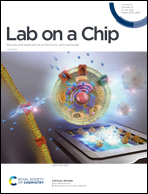Microfluidic generation of ATPS droplets by transient double emulsion technique†
Abstract
An aqueous two-phase system (ATPS) is considered as a promising candidate for biological applications due to its excellent permeability, selective separation, rapid mass transfer and all-biocompatible nature. However, it remains difficult to generate ATPS emulsions with controllable and prolonged stability due to ultra-low interfacial tension. Here, we present a transient double emulsion (TDE) technique to address this challenge. The method involves two steps: (i) water-in-oil-in-water (W1/O/W2) transient double emulsion droplets are first produced with droplet microfluidics by introducing an additional middle oil phase, and (ii) the W1/O/W2 droplets dewet into oil-in-water and ATPS droplets in a controllable manner. Using the TDE method, both dextran-in-polyethylene glycol (PEG) and PEG-in-dextran ATPS droplets can be generated with high uniformity (coefficient of variation (CV) ranging from 0.66% to 2.55%), a wide range of droplet sizes (∼100 to 250 μm in radius), and tunability in the generation frequency (∼4 to 170 Hz). Tuning the oil viscosity controls the destabilization time for on-demand dewetting and releasing of aqueous core droplets. The stability of ATPS droplets is significantly improved by storing aqueous droplets in double emulsion vessels, which would benefit various applications, such as small molecule encapsulation.

- This article is part of the themed collection: Lab on a Chip HOT Articles 2021


 Please wait while we load your content...
Please wait while we load your content...